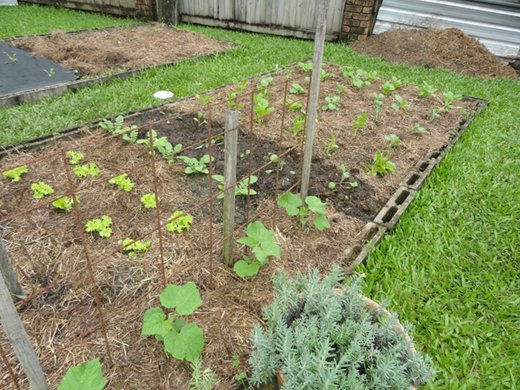It's not just in the kitchen that we can all cook from scratch - we can do it outside too by making our own organic liquid fertilisers. These fertilisers are easy to make, are made using leaves and other organic matter in your own backyard, they're effective and they'll save you money.
Above and below are the first of our new season gardens. It's been slow going this year because we've had so much rain. At the moment, the soil is too saturated to plant anything.
These fertilisers are gentle, just the right thing to give to newly planted seedlings and to apply frequently, in a weak form, to your plants. They're also excellent sprayed over the leaves, not just onto the roots. If you're in a cold area, the nitrogen in the soil will not be available until the soil warms up a bit, so sprinkling liquid fertiliser over the leaves will feed your plants when they need a boost.
This is how the gardens have been looking the past few weeks. We still have these three to be weeded and planted up again. It looks sad now but it doesn't take long for them to spring back to life.
My favourite liquid fertiliser is comfrey tea and as far as I'm concerned it's the star of the homemade fertilisers. We have a clump of comfrey growing near the chook house. At the moment the leaves are huge, and it's standing at about a metre tall. People tell you that comfrey spreads and you have to be careful, but that's not quite right. It doens't spread out like bamboo does but if you plant comfrey in a hole, you'd better make sure that is where you want it to grow forever, because if you try to dig it out later, leaving only the slightest peice of root behind will make it grow again. Choose your spot carefully - either at the edge of your garden or near the compost heap and you'll have your own source of nitrogen, potash, phosphorus (NPK) and calcium for life. Comfrey sends down a long tap root and that root mines the soil for minerals and makes them available in the leaves. Using those leaves in a tea, will give you those minerals and they're the same ones you buy as NPK at the gardening shop.
This clump of comfrey has been growing in our backyard for about 14 years. It hasn't spread out at all but I know that if I wanted to move it to another location it would be almost impossible. Make sure of your spot before you plant comfrey.
To make comfrey tea, cut a clump of comfrey leaves and put them into a large bucket that has a lid. You can put a brick on top of the leaves if you like, so they don't float. Fill the bucket with rain water, put the lid on and leave the brew for two weeks. When you take the lid off, stand back, it will smell.
A lot.
Remove the infused comfrey leaves and throw them onto the compost. What is in the bucket now is comfrey tea concentrate. Make up the tea using about a cup of the concentrate to a bucket of water. You want this tea to be the same colour as a cup of weak tea. Mix it up in your watering can and sprinkle it over your seedlings. Comfrey tea is excellent on tomatoes, potatoes, beans, peppers etc - all the flowering vegetables.
You can make liquid fertiliser using many common garden leaves - if the leaves contain a good concentration of nitrogen, they are suitable. Most liquid fertilisers can be made in the same way. The steps are:
- Harvest your leaves, nettles, weeds, seaweed etc and place them in a bucket with a lid.
- Fill the bucket with water.
- Wait two weeks.
- Dilute the concentrate to look like weak tea before you use it.
You can also make compost tea and liquid manure tea. To make these teas, get a hessian bag or an old pillow case and place your materials in there. About a shovel full of compost or any aged animal or poultry manure will do. If you don't have aged manure, you can use poultry manure pellets (Dynamic Lifter) - about a cup full to a bucket. Tie up the top of the bag so it's like a big tea bag. Place the bag into a bucket with a lid, fill the bucket with water, top on, wait two weeks. Dilute before using it. Easy!
We still buy these fertilisers - trace elements, seaweed concentrate and sulphate of potash - they're all organic. If we had access to seaweed, we'd make that ourselves too but it is illegal to remove seaweed from a beach where I live.
Like almost everything else we do in our lives, these simple fertilisers take a small amount of time and effort but the rewards are evident. It allows us to use what we have here, it is cheaper, we're not bringing in plastic packaging, and we know what is in the products we're using. It certainly makes sense to us to make these things rather than buy them.







